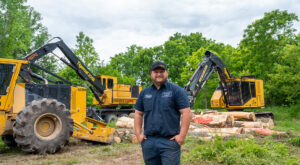— Paul Iarocci
According to the West Virginia Forestry Association, West Virginia is the third most forested state in the US with nearly 12 million forested acres (4,8 million ha), 94% of which are comprised of hardwood species. It is in this richly endowed region that Mt. Lake Park, Maryland contractor J&B Logging Inc. operates in. Owner, Jimmy Glotfelty started logging with his brother in 1995 and went on to form his own company, J&B Logging Inc., in 2003. It was initially a hand falling operation. As mechanization took hold, Jimmy like many other contractors in the area, invested in a Timbco zero tail-swing feller buncher equipped with a bar saw. This was an ideal combination for selective felling large, top-heavy hardwood trees on steep slopes.
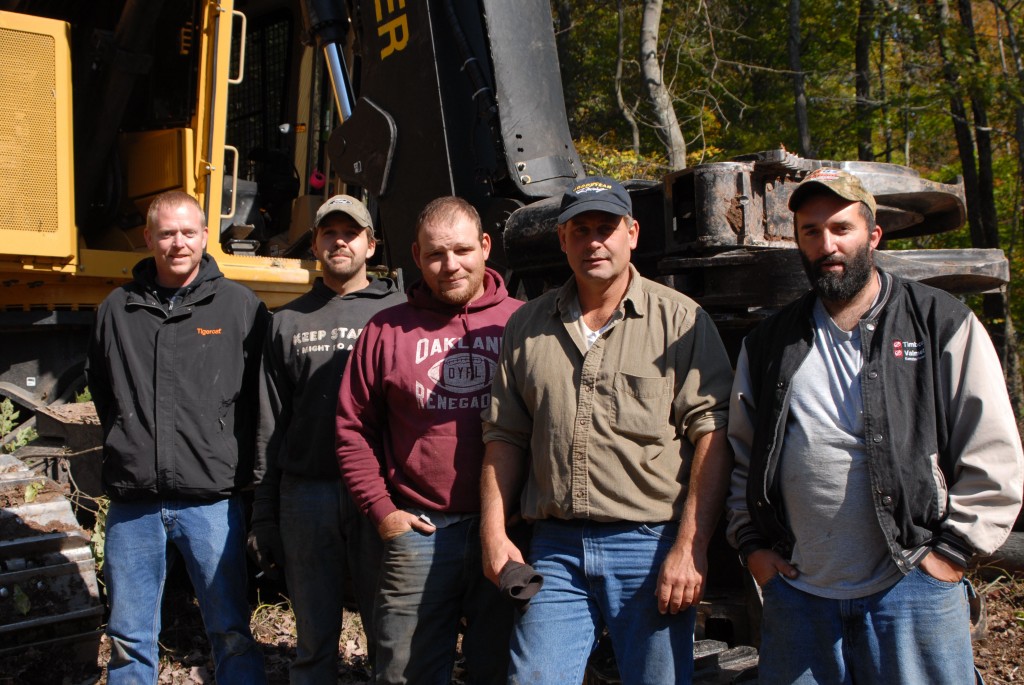
The J&B Logging Inc. crew soon after taking delivery of the LX830C in late 2010. (L-R) Tigercat district manager Jerry Smeak, Eric Savage (hand faller, dozer operator), Lynn Sisler (LX830C operator), Jimmy Glotfelty (owner) and Brad Beckman (240B loader operator). Skidder operator, Terry Alexander, is absent.
West Virginia’s steep terrain and often wet soil conditions limit the mobility and effectiveness of grapple skidders so additional duties were piled on to the track feller bunchers – namely removing large limbs, topping the trees and shovelling the wood within easier reach of the skidders.
Jimmy bought his first Tigercat – a 240B loader – from Lyons Equipment back in 2004. The machine has since accumulated over 12,000 virtually trouble free operating hours. “I’ve never touched the 240,” asserts Jimmy. “It is a good machine.” The loader is equipped with a bar saw slasher. Its main duties are sorting, bucking and loading shortwood logs and pulpwood.
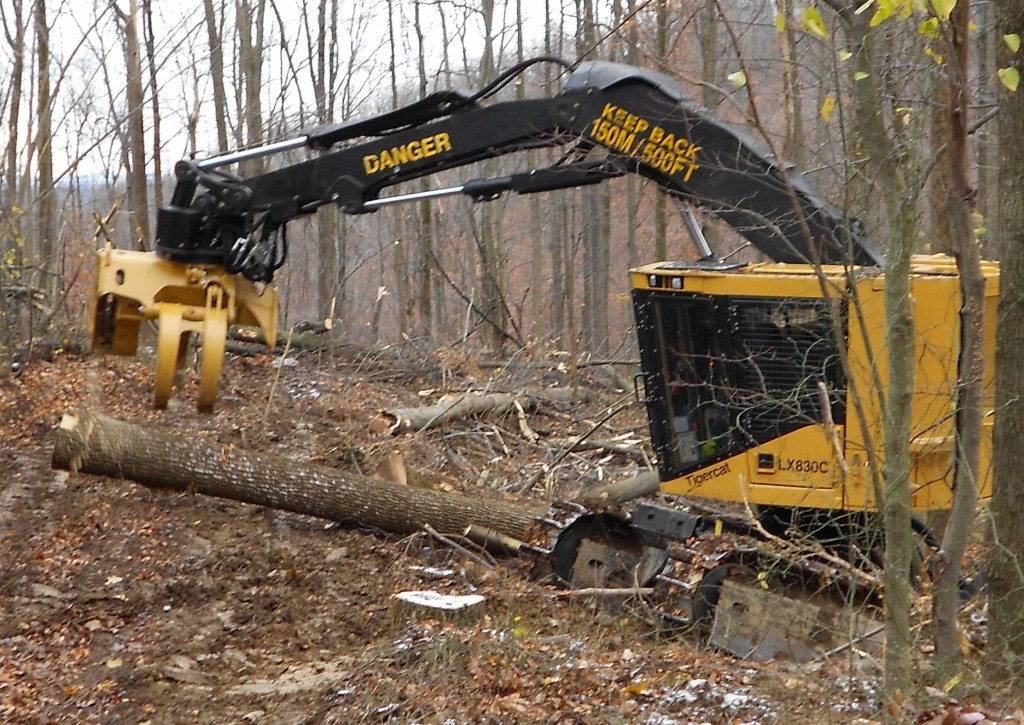
Shovel logging duties.
Based on the performance and reliability of the 240B and Jimmy’s relationship with Lyons Equipment salesman Jerry Smeak, (now Tigercat district manager for Pennsylvania, Maryland, Ohio and West Virginia) Jimmy bought a 630C skidder in the summer of 2007, replacing a smaller Timberjack 460. “It is my main machine,” he emphasizes. Jimmy has since purchased another small skidder to work in conjunction with the 630C.
Again, it is the reliability and high uptime rates that have impressed Jimmy because machine availability is crucial to his operation. He runs a tight four-machine felling, skidding, loading and hauling operation. There is very little wood on the ground and the terrain leads to very small decking areas and hence not much of a buffer. A machine failure can quickly bring the operation to a standstill.
The 630C is usually confined to the main skid trail. The terrain and road layout often necessitate steep, uphill skidding. “The terrain is normally straight up and down, all uphill skids,” explains Jimmy and then nodding toward the current tract, which sits on a gentler ridge, he says, “This terrain is pretty good.”
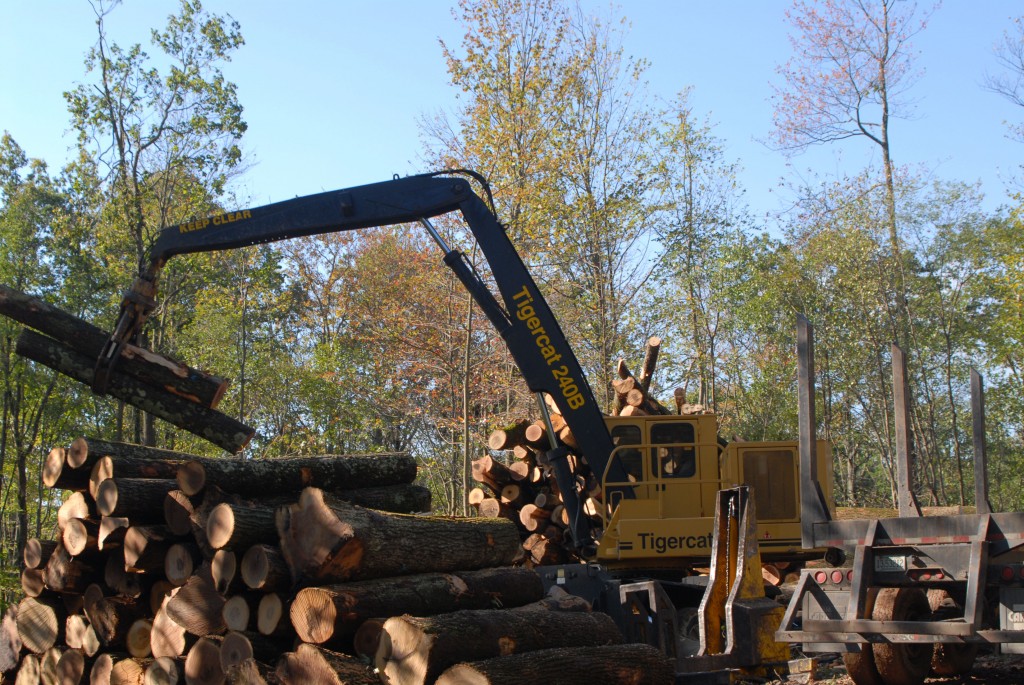
Jimmy’s 12,000 hour 240B looks like new.
Jimmy’s latest Tigercat acquisition came in fall 2010. He purchased from Ricer Equipment (based in Lucasville, Ohio) an LX830C leveling feller buncher originally fitted with a third party bar saw. “I’ve had a couple of Timbcos and then I thought I’d try this Tigercat which I think is going to do a pretty good job and last a little longer,” commented Jimmy upon taking delivery of the machine.
Jimmy notes that the LX830C is a bigger machine than a Timbco 445. “This machine is a lot heavier. It takes more to move it around. Hopefully we only move at the most six times a year.”
Operator Lynn Sisler comments that the machine feels more stable. Jimmy concurs, adding, “It is a foot longer and six inches wider.” When asked if there are any disadvantages to running a bigger machine than the 445, Jimmy responds, “You learn how to run it in the tight spaces. You can actually do better in the woods with a machine selective felling than you can do by hand. I felled by hand for probably the first eight years.”
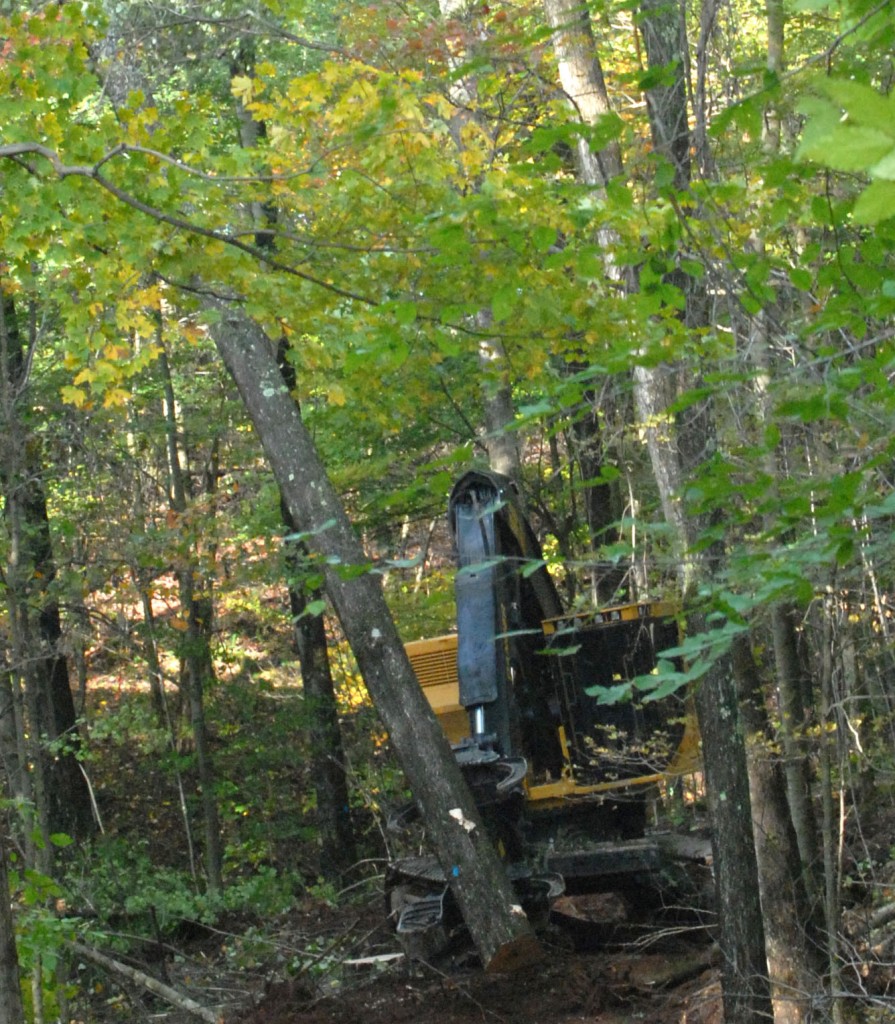
Operator Lynn Sisler flicked the trees backward with the previous head, contributing to the problems. The superior structure of the 5185 coupled with the 340 degree wrist should address these issues.
Even at 36 000 kg (80,000 lb), the bar saw equipped LX830C is a very versatile and extremely agile machine in these tight selective felling applications and ironically is dwarfed by the large hardwood in the stand. Generally, the trees are felled and where possible, laid parallel to the tracks, alongside the machine. This reduces track travel by shortening the distance to the top end of the tree. This motion was limited by the 40 degree maximum rotation of the original head. Lynn would compensate by opening the bottom arms first, tilting the head and flicking the tree backwards to bring it parallel to the tracks and as far Operator Lynn Sisler flicked the trees backward with the rearward as possible.
In fact, when Jimmy received the machine, he immediately cut off the top horn, shortening the overall height of the head in order to allow Lynn to more easily flip the butts forward.
After felling a large tree, Lynn tracks or reaches back to the top end of the tree, removes the large limbs, tops the tree and bucks it into manageable lengths if necessary. Finally the trees are shovelled to the skid trail and bunched at approximately a 45 degree angle with the butts lined up on the trail.
Although Jimmy says that on most of his tracts the timber is quite a bit smaller, these trees are big, sometimes requiring double and triple cuts. With very large limbs, they are also top-heavy and hard to handle. Despite the difficulty in dealing with the large, awkward trees, “It is easier to get the production with bigger timber,” says Jimmy.
After only a week or two in this tough duty cycle – the extra handling and shovelling of the oversized wood – the trouble began. The bar saw began to break down on a weekly basis, failing the lower clamp arm or the saw unit. The situation was causing a great deal of lost production and reflecting negatively on the LX830C carrier.
Duane Barlow, Tigercat product manager for attachments explains, “The head looked robust and was said to work well in the Pacific northwest. Unfortunately it was not robust enough for West Virginia select cut hardwood.”
Tigercat president, Tony Iarocci, visited Jimmy and promised a resolution of the issues with the head. Tigercat attempted to work with the head manufacturer but the company failed to provide a viable and timely solution for the structural or saw unit issues.
Then Barlow and his team looked for an alternative head among a half dozen different manufacturers. “None of them provided the combined features of durability, simplicity and cost effectiveness to suit the application,” says Barlow. “Jimmy’s comment was, ‘Why doesn’t Tigercat just build a bar saw?’ So we did a basic layout starting with the saw box design from our harvesting head, with two arms and our 340 degree wrist. The concept was reviewed and we got the green light to move forward.”
The detailed design process began with a review of the specific application and other heads used in similar applications. The layout was completed with the idea of building a strong, simple, productive head that would provide superior versatility for felling, limbing, topping and shoveling.
“A compact head design with thick, high-strength plate used in a fully boxed construction gave the needed durability,” explains Barlow. “Adapting our proven 340 degree wrist with a new control manifold would provide the needed dexterity. A grapple-like pair of clamp arms was designed with one double-tine arm and one single tine, using independent cylinders for maximum control. The arm pivot pins are three inch diameter and similar in design to those used in our skidder grapples.”
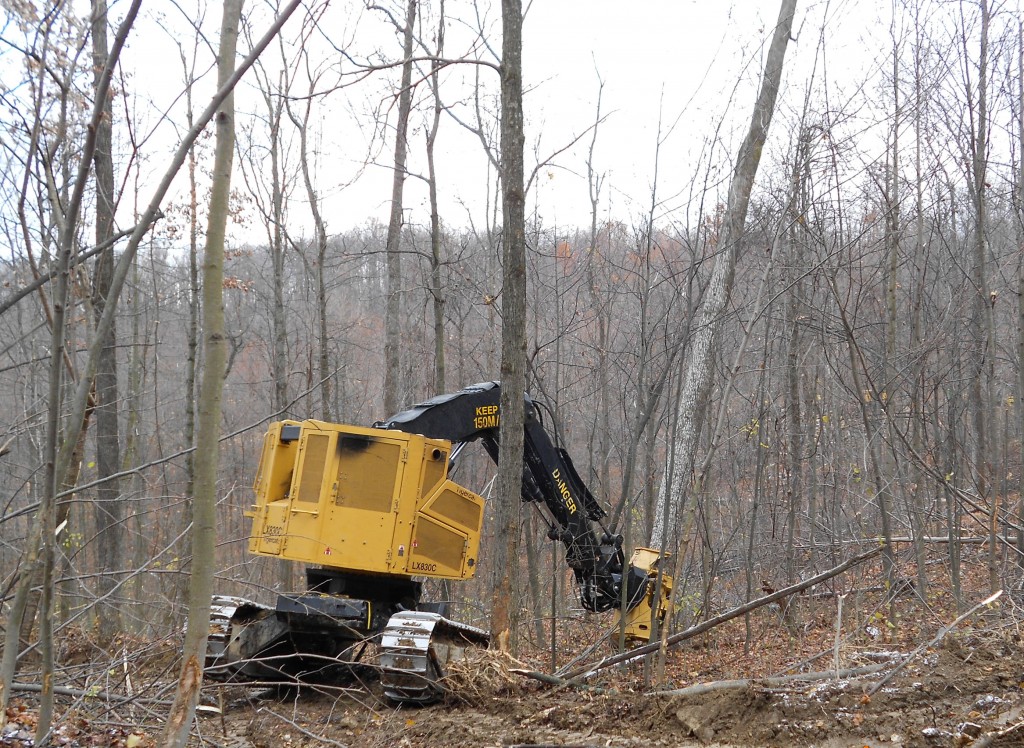
In the thick of it. The LX830C adeptly cuts and controls the large timber within the tight natural stand.
Using design knowledge from the harvesting head program, Barlow’s team designed a new high performance 19 mm (¾ in) pitch saw unit. Mounted on two pins with spring support to allow the saw unit to move when loaded vertically, the design minimizes bent bars. The saw is available with a manual tensioner or an optional hydraulic tensioner as well as optional saw home and position sensors. The saw control manifold is available with either pilot or solenoid control to suit the carrier and application. Jimmy opted for simplicity, choosing the manual tensioner, no sensors and full pilot control. He did purchase the optional 340 degree wrist.
The hydraulic control is designed to work with Tigercat carriers, providing fast arm speeds, superior grip and enhanced saw performance. Electronic control of the sawing functions was optimized with input from Jimmy, providing full manual control plus automatic features to suit the select cut and limbing applications, with adjustments to suit operator preference. Jimmy says he is extremely happy with the Tigercat 5185 and that it was worth the wait. The head has worked over 550 hours with no mechanical failures or downtime.
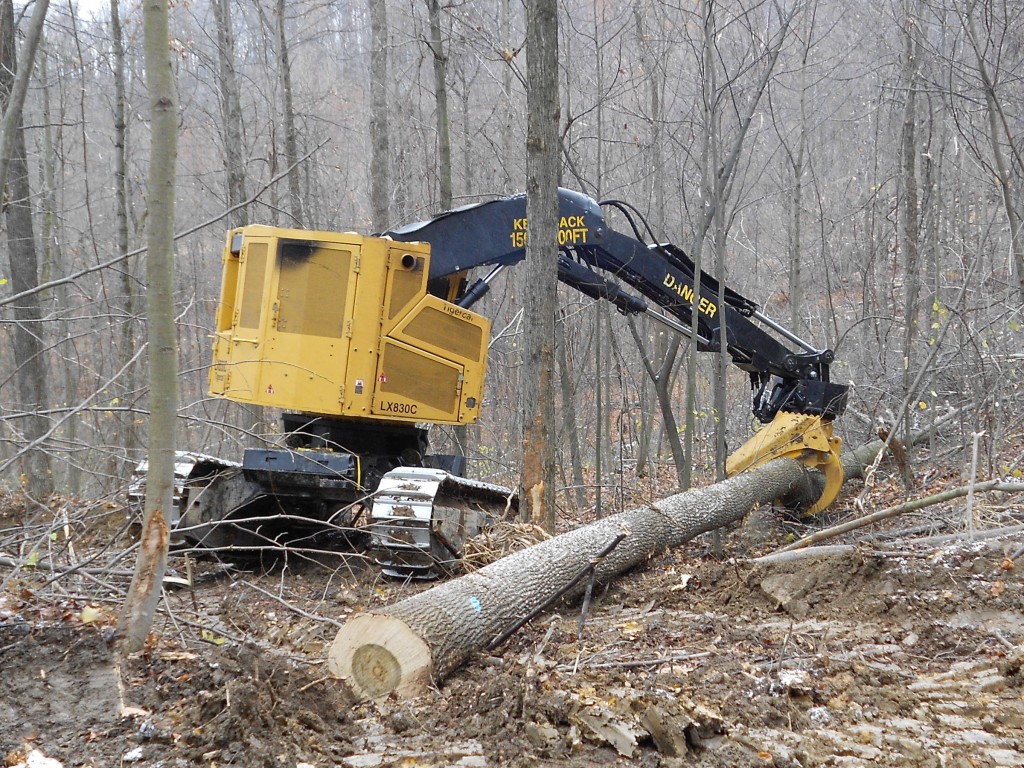
Sisler routinely limbs and bucks the trees in-stand.
Back at roadside, the 240B is loading shortwood saw logs onto one of Jimmy’s two trucks. He contracts out a third truck, which provides enough hauling capacity for the six to seven loads that J&B produces daily.Jimmy and his crew are felling high value hardwood used to produce high grade boards. “This load will go to the Allegheny sawmill in Kingwood, West Virginia. We cut cherry, soft and hard maple, white and red oak, beech, birch and hickory.” Allegheny not only demands a quality product but also emphasizes the importance of preserving the standing timber. “The residual timber we are leaving? That’s why I got Logger of the Year. You just don’t go in and cut a tree here and there,” says Jimmy, gesturing toward the stand with a wave of his arm. “You can look in there – the tops aren’t broke out. They want to come back every ten to twelve years and cut’em again.”
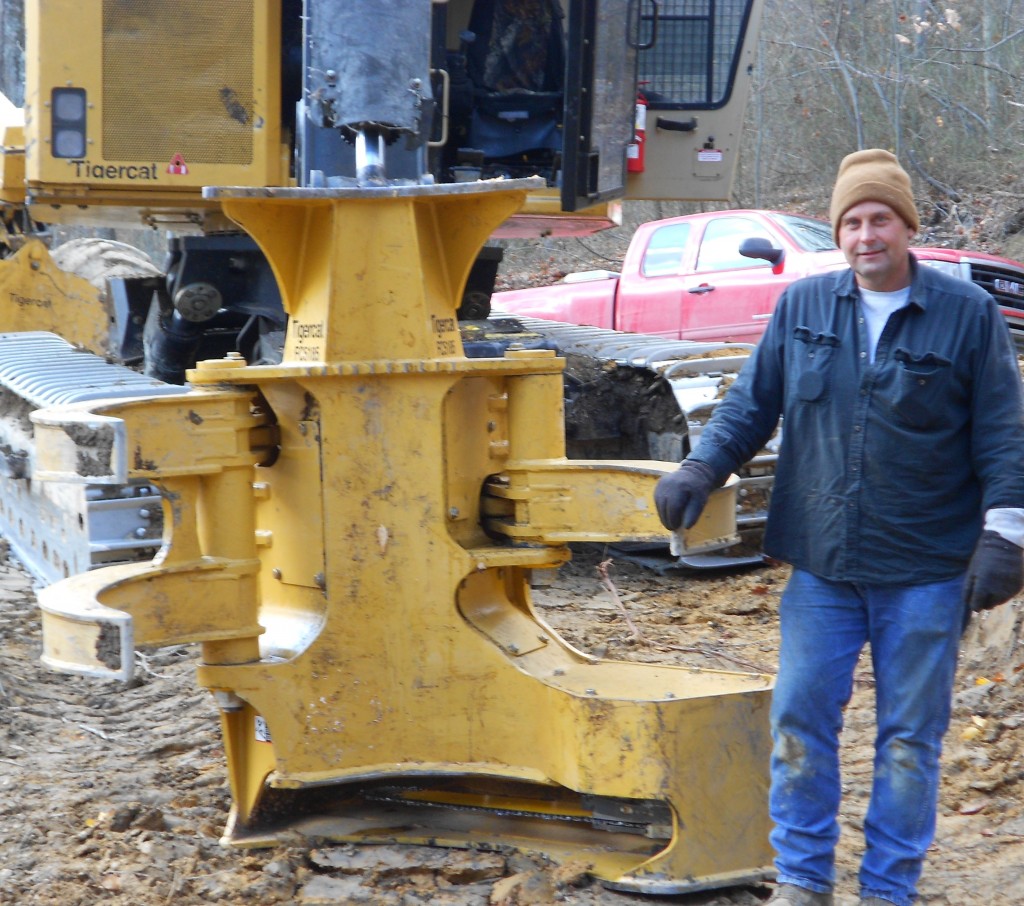
It took a year but Jimmy finally received his new Tigercat bar saw. He says it was worth the wait.









